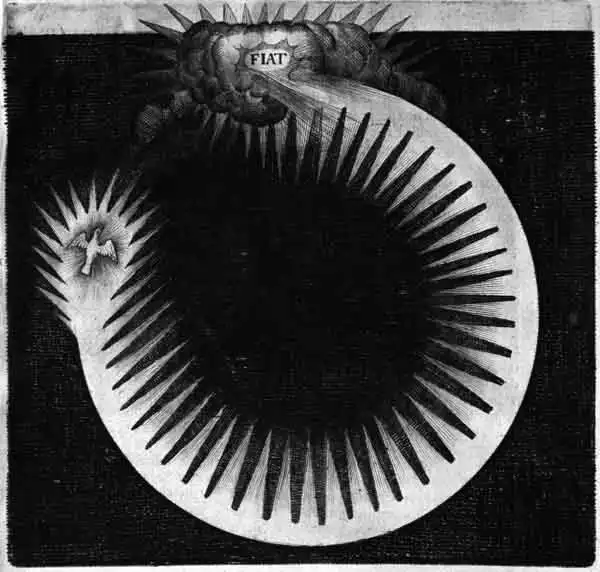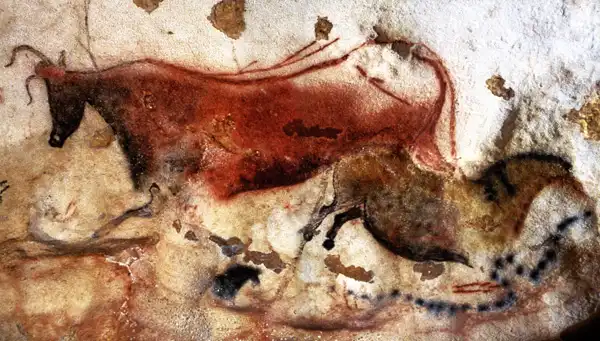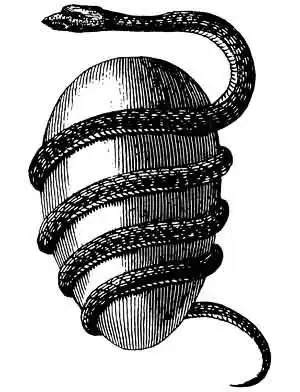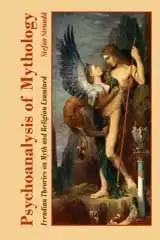Creation Myths
Introduction to the Emergence and Meanings of Creation Stories
Some quests for the human mind have been with us as long as we've been around, and the most intriguing of them all is the very search for our beginning. Where, when and how did it all start? The classic Indian text Rig Veda states with poetic clarity, just how grand a quest the search for such answers is:
he, whether he fashioned it or whether he did not he, who surveys it all from highest heaven, he knows — or maybe even he does not know.
Narrow-Minded ArchetypesIn penetration of such myths, a psychoanalytic perspective based on C G Jung's theories is frequently used. Gods are said to represent the archetypes, and mythical events are symbols of man's pursuit of self-realization.This way of looking at creation myths may very well be triggered by the fact that these old explanations of the birth of man and cosmos are quite contradictory to what science tells us, therefore a symbolic and psychological interpretation of the myths seems to be the only way to claim their value for present man. The myths are described as expressions of human emotional needs, the details and ingredients in them are said to evolve from the dark corners of our subconscious — somewhat like dreams. This is, of course, a narrow-minded perspective. Not only does it all too readily assume that modern science has found all the true answers, but more serious is the implication it contains, that people of the past had no ability for scientific, deductive reasoning, maybe not even a genuine interest in questions of this nature.
Homo RudisBefore we assume that our ancestors' explanations are mere emanations from the subconscious, we must at least try to see if their theories might have made good sense at the time. We should remind ourselves that not long ago did our prestigious science believe the earth to be in the center of the universe, furthermore they believed it to be no older than six thousand years. In those days, this all made good sense.
 So, let's try to follow the thoughts of our ancestors, when they pondered on the world and its distant past, and see what conclusions this must have led them to. The myths stem from times when very little was known about nature and its laws, so we have to think like someone almost completely ignorant — let's call him homo rudis, the unlearned man. When homo rudis studies the world around him, he sees people being born and dying, he sees his race multiplying from generation to generation, and wonders where it all started. Must there not have been a first man and woman, and if so — where did they come from? Being the first people, their creation must have been the work of others. The same must be true for animals and plants.
People Out of TearsSure enough, a primordial couple is found in most creation myths. Adam and Eve have their counterparts, for example in the charming Nordic myth of Ask and Embla — the first a tree, the second a vine embracing it, before the gods made them into man and woman. In the Mayan legend of Popol vuh, people are made out of corn, in Egyptian myth out of the tears of the sun god Re — and certainly our species has been cause for crying several times since.In many a myth, man is made in a beastly fashion that our deeds give good reason to assume — like the Babylonian tale Enuma elish, where people are shaped out of the blood and veins of an executed god. Marduk, the initiator of man's creation, has a clear purpose for him:
the service of the gods That they might be at ease! But of gods or out of nature's ingredients man and woman are created — fully grown adults at the moment of their coming into being, except for the tales of the Eskimos on Greenland, where the first people are children growing out of the earth. There they lie, one day, with closed eyes, unable even to crawl. The earth itself feeds them.
Anything Not Being BornMost creation myths state it clearly: when the first man and woman were born, they immediately started to reproduce. All the people in the world come from these extraordinarily conceived ancestors. Also animals and plants, obviously chained to the cycle of birth and dying, are believed to have a beginning much like that of man.Then homo rudis asks himself — is there anything eternal, neither being born nor giving birth? The sun is reborn each day, the moon and stars each night, the mountains wither, the soil is washed away by rain. What remains? Well, the air seems ever present, but to the mind of homo rudis its presence is so vague that it's rather taken for granted, somewhat like the space in which we all move. You cannot touch it, and not move away from it. There's something much more palpable, and still seemingly eternal: the sea. The sea stretches further than the eye can see, deeper than man can reach, it chews on land much like man bites the flesh from the bones of his prey. The land seems to have been raised out of the sea, and surely it can be swallowed into the sea again. Homo rudis will find it hard to imagine a time when the sea was not.
Primordial SeaIn Jungian analysis of myths, the primordial sea is regarded as a symbol of chaos, which is an interesting — although unnecessary — way of explaining the fact that it is present in almost every creation myth we know of. When homo rudis searches for something eternal, he will find the sea by pure observation and deductive reasoning, whatever his subconscious might point out.Well, modern science tells us that life itself was born in the sea, and that all plants and creatures on land came from the sea. Homo rudis did well, in pointing out the sea as a prerequisite for creation. The sea and the water are essential elements in most myths of creation. In Enuma elish of the Babylonians, there is at first Apsu, the sweet water entity, and Tiamat, the salt water entity, in separate dwellings. Then Mummu, a trickster type of god connected to the rain, makes them meet, and thus creation begins. Rain brings sweet and salt water together. Doesn't it make good sense? In the Japanese myth of Kojiki, the twin gods Izanagi and Izanami stir up the ocean with a spear, making an island appear. There they settle down and embrace in a fashion so lustful, that the 19th century English translator Basil Hall Chamberlain felt the need to switch to Latin. Out of their incestuous copulation the world is born.
Fire Meets IceThe Viking tales show some variation to the theme. There is in the beginning a great gap called Ginnunga, which simply means immeasurable. In this gap fire meets ice, and in the water from the melting ice the very painstaking process of creation takes place.Even the Bible has its primordial sea, in the book of Genesis, where God's spirit "hovered over the surface of the water". Although the Bible is usually said to describe creation from nothing, creatio ex nihilo, this is not clearly the case. Genesis starts with the words: "In the beginning God created the heavens and the earth", but then he explicitly makes the heavens on the second day of creation. The introduction should be read merely as a headline. This is most likely the case also with the second tale of creation in Genesis, starting (at 2:4) with a similar phrase. It is very hard to find a myth, where the world is created out of nothing. It's vaguely hinted in the Zoroastrian text Avesta and in the Koran, among the few. In almost all cases, even when nothingness is implied, there is really in the beginning: something. The problem of imagining something out of nothing is obvious to everyone who ever tried it, also to modern scientists. They find it just as hard to settle with the Big Bang theory.
What Do Gods Have in Common?In all creation myths, gods of some sort are the initiators of worldly life. They're not at all as eternal as the sea, nor do they handle their affairs with such a firm control and clear intention as the Christian god is generally assumed to have done. Rarely do they have his exclusive monopoly.Really, to call them "gods" is saying almost nothing about them. What can the Egyptian sunrise creature Chepre have in common with the vindictive Odin of Nordic tales, or the almighty Jahve? Their personalities differ immensely, as do their powers and their functions. Even when it comes to the act of creation, they have such different ways to go about it, that it doesn't make much sense giving them the same title. Although most of them are far from almighty, and some of them just as mortal as ordinary men, it's most certainly the Christian god who's been their measure. The studies of myth and religion have been conducted by Christians, consequently within a Christian framework and terminology.
Laws of DramaThose mythical figures we call gods, really behave just like humans. They fall in love, they act on impulse, and frequently regret their actions. The most firm of rules about them — and it seems, alas, for man as well — is: as soon as there is more than one of them, they start fighting each other.The roles of the different gods in these myths could fit into those of Jung's archetypes, but more readily into the laws of dramaturgy. Already the ancient Greeks knew what rules to obey, to make a drama meaningful and exciting. Aristotle put it in writing in his "Poetics", some three hundred years BC. The laws for good drama are easier to spot in myths and tales of old, than are the depth psychology theories. One example is the threesome of most tales, often explained with the number three being of symbolic significance. Yet, when a story is told, three times is the minimum of repetition needed to get the dramatic effect: the first time is a unique event, the second makes a pattern and the third breaks it. Any fewer than three is not possible, more is not necessary. Also, the laws of drama mention characters necessary to push the plot on, and what roles they must have. Some of them, like the hero and the so called shadow, even have the same names as Jungian archetypes. Their roles, though, differ some. Myths are found to be quite reasonable attempts of old, to explain the world we live in, but they are also stories, often kept alive only by telling from one generation to the next. They would probably not have remained in our memories, were they not exciting to the listeners.

MYTH
IntroductionCreation Myths: Emergence and MeaningsPsychoanalysis of Myth: Freud and JungJungian Theories on Myth and ReligionArchetypes of Mythology - the bookPsychoanalysis of Mythology - the bookIdeas and LearningCosmos of the AncientsLife Energy EncyclopediaOn my Creation Myths website:
Creation Myths Around the WorldThe Logics of MythTheories through History about Myth and FableGenesis 1: The First Creation of the BibleEnuma Elish, Babylonian CreationThe Paradox of Creation: Rig Veda 10:129Xingu CreationArchetypes in MythAbout CookiesMy Other WebsitesCREATION MYTHSMyths in general and myths of creation in particular.
TAOISMThe wisdom of Taoism and the Tao Te Ching, its ancient source.
LIFE ENERGYAn encyclopedia of life energy concepts around the world.
QI ENERGY EXERCISESQi (also spelled chi or ki) explained, with exercises to increase it.
I CHINGThe ancient Chinese system of divination and free online reading.
TAROTTarot card meanings in divination and a free online spread.
ASTROLOGYThe complete horoscope chart and how to read it.
MY AMAZON PAGE
MY YOUTUBE AIKIDO
MY YOUTUBE ART
MY FACEBOOK
MY INSTAGRAM
MY TWITTER
STENUDD PÅ SVENSKA
|
 Archetypes of Mythology
Archetypes of Mythology Psychoanalysis of Mythology
Psychoanalysis of Mythology